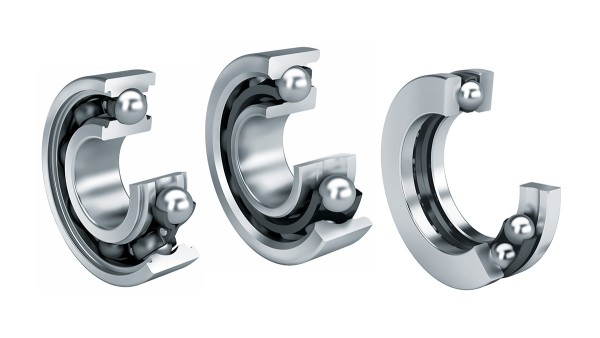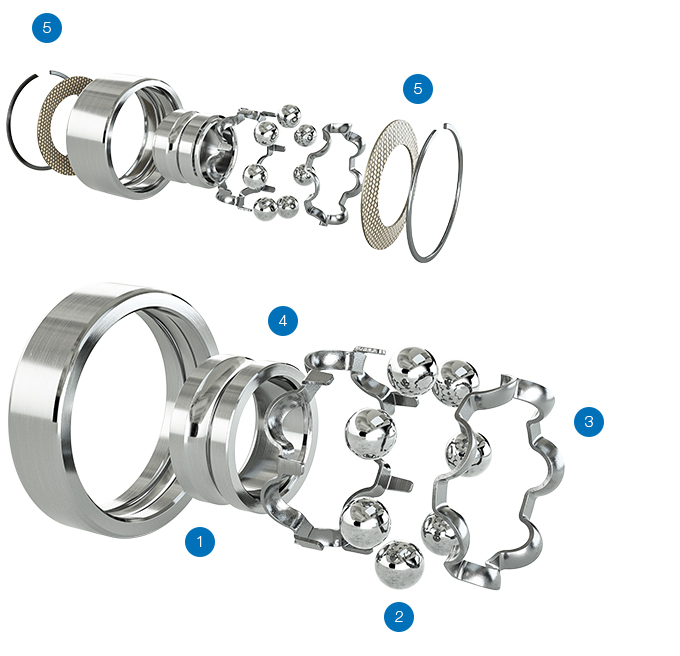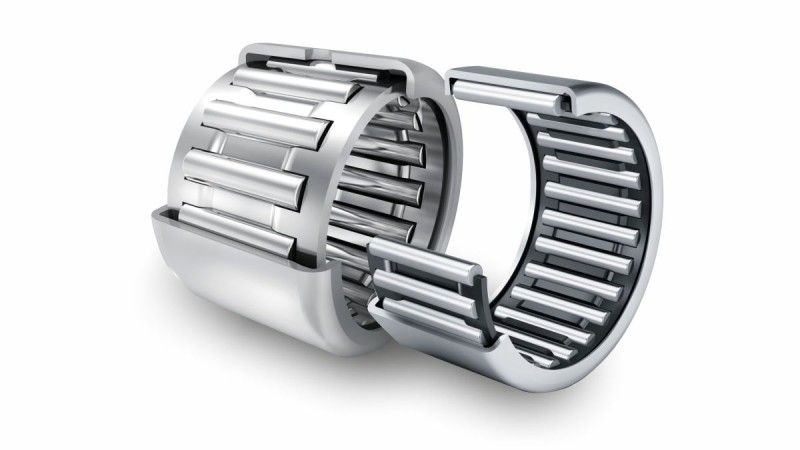
Rotating Motion: The Role of Ball Bearings
Ball bearings are mechanical components designed to reduce friction between moving parts while supporting rotary motion. They consist of an inner ring, an outer ring, and a set of steel or ceramic balls positioned between them. Balls made of steel or ceramic, are precisely spaced by a cage, facilitating free rotation.
Construction of Ball Bearings
Ball bearings consist of an Inner ring or raceway, an outer ring or outer raceway and balls with our without a retainer.

1. Inner and outer ring are made of chrome steel 52100 (100Cr6) or 440C or (X65Cr13) stainless steel or Cronidur 30 (X30CrMoN15-1)
2. Ceramic or steel balls
3. Retaining cage sheet steel, polymide, or phenolic
4. Load-carrying lubricants thousands to choose from
5. Shields and seals made of sheet steel, Teflon-coated fiberglass fabrics or reinforced Phenolic
Working Principles of Ball Bearings
Ball bearings operate based on the principles of rolling contact, which differ from the sliding contact encountered in plain bearings. The working principles involve the following concepts:
Rolling Contact: As an external force is applied to the bearing, the balls roll between the inner and outer rings. This rolling action significantly reduces friction compared to sliding contact, enabling smoother rotation.
Raceway Curvature: The inner and outer rings of a ball bearing have carefully engineered curved surfaces known as raceways. These raceways ensure that the balls make contact at specific points, distributing the load evenly and minimizing stress concentrations.
Lubrication: Proper lubrication is needed for efficient operation of ball bearings. Lubricants reduce friction, dissipate heat, and protect against wear and corrosion. Common lubricants include grease and oil, chosen based on the application’s speed, temperature, and load requirements.
The Role of Ball Bearings in Rotary Motion
Ball bearings are used for their ability to minimize friction between moving parts. By introducing rolling contact between the balls and the inner and outer rings, they significantly reduce frictional resistance. Friction reduction leads to enhanced efficiency, decreased energy consumption, and reduced wear.
Load Distribution
In many applications, loads need to be supported during rotary motion. Ball bearing design distributes the loads evenly across the inner and outer rings. The use of multiple balls in a bearing increases the contact area and allows for the transfer of higher loads without compromising the smoothness of rotation.
Working Principles of Ball Bearings
Ball bearings operate on fundamental principles of physics, including Newton’s laws of motion and Hertzian contact theory. When a load is applied to the bearing, the balls roll between the rings reducing the frictional forces. The rolling action allows the bearing to accommodate both radial and axial loads, ensuring stable and efficient rotation.
Applications of Ball Bearings in Rotating Machinery
Automotive Industry
In the automotive sector, ball bearings are widely specified in wheel hubs, gearboxes, and engines. Precision bearings, like the SKF and TPI 6200 series part numbers 6201,6202,6203,6204,6205,6206,6207,6208,6209 and so on, are instrumental for their load-bearing capacity and resistance to high temperatures, allowing vehicles to operate smoothly under varying speeds and conditions.
Industrial Manufacturing Equipment
On factory floors, machines such as lathes, milling machines, and electric motors rely on the durability of ball bearings. For high radial and axial loads, bearings such as the TPI, FAG, and INA 6200 and 6300 series provide medium and heavy duty capability for machinery operation with precision and reliability.
Aerospace Applications
Aerospace Precision Bearings must operate without fail in extreme conditions . Bearings like the FAG B71800 and B71900 series, are high precision ACBB and have the ability to function at varying speeds and temperatures. This series are found in aircraft systems, supporting critical rotating components.
Home Appliances
Even in the household, ball bearings play a vital role. The TPI 600 series bearing part numbers 606,607,and 608, for example, are found in washing machines, refrigerators, and air conditioning units, providing quiet and efficient operation, crucial for consumer satisfaction.
Medical Equipment
In the medical field, the smooth and accurate movement provided by ball bearings is indispensable, particularly in equipment such as centrifuges and MRI machines. Bearings like the NMB R series part numbers R2, R3, R4, R6 and R8 are chosen for their precision and the ability to maintain performance in sterile environments.
Electronic Devices
Ball bearings are also pivotal in the functioning of computer hard drives and fans. Bearings like the NMB 600 and 6200 series allow these devices to run quietly and dissipate heat effectively, which is essential for the longevity and functionality of electronic components.
Ball Bearings Selection Criteria
The selection of ball bearings is a critical decision in the engineering of rotating machinery, one that directly impacts efficiency, durability, and performance.
Key criteria involved in choosing the right ball bearings for various applications.
- Load and Life Ratings – a consideration is the bearing’s ability to withstand both radial and axial loads without compromising its life. Bearings like the SKF Explorer series are engineered to offer superior load capacity and enhanced service life, crucial for heavy-duty machinery that requires both high reliability and longevity.
- Speed Requirements – the operational speed of the machinery dictates the need for bearings that can sustain high rotational velocities without excessive heat generation. The TPI high-speed precision ACBB series, designed for machine tools and spindles
TPI ACBB bearings are capable of extremely high speeds and accuracy. Buy TPI Angular Contact Ball Bearings.
- Precision and Tolerance Levels – for applications demanding high precision, such as in CNC machines or aerospace components, bearings must meet exacting tolerance levels. The FAG precision ball bearings, known for their tight dimensional accuracy, are often selected for their consistent performance in precision applications.
- Environmental Conditions – operating environments with extreme temperatures, contamination, or moisture require bearings manufactured with materials and seals designed for such conditions. For instance, FAG’s S6300-2RSR stainless steel series offer corrosion resistance and are equipped with seals to protect against contaminants, making them suitable for harsh industrial environments.
- Noise and Vibration Considerations – in applications where noise and vibration are a concern, such as in automotive or office machinery, choosing bearings designed to operate quietly is essential. The TPI Silent Series is an example where the bearing design minimizes noise, improving user comfort and machine performance.
- Material Composition – the material of the bearing is chosen based on the specific application needs, whether it’s standard bearing steel for general use, ceramic for high-speed or high-precision applications, or specialized alloys for extreme environments. For instance, SKF’s ceramic hybrid bearings combine the strength of steel with the low-density advantages of ceramic balls.
- Installation and Maintenance – ease of installation and maintenance can influence bearing selection. Bearings with advanced sealing technologies or pre-lubrication, like SKF’s sealed ball bearings, can reduce maintenance needs and simplify the installation process.
Examples and Calculations
Rolling Resistance Calculation:
The rolling resistance of a ball bearing can be calculated using the formula:
R = (0.002/3) × f × W × D
Where:
R = Rolling resistance (N)
f = Coefficient of rolling resistance (typically ranging from 0.001 to 0.003)
W = Load on the bearing (N)
D = Bearing diameter (m)
By calculating the rolling resistance, engineers can optimize bearing selection, reducing energy consumption and improving overall performance.
Preload Calculation
Preload refers to the intentional application of a slight internal axial load on a ball bearing to improve its stiffness and reduce operational clearance. The preload force can be determined using equations that consider the bearing geometry, the desired preload level, and the intended application’s load requirements.
The application of ball bearings has revolutionized the field of engineering by facilitating smooth, low-friction rotary motion in a myriad of mechanical systems. Through their ability to reduce friction, evenly distribute loads, and enhance operational efficiency, ball bearings have become indispensable components in a wide range of industries. Understanding the working principles, employing scientific calculations, and optimizing their use enable engineers to harness the full potential of ball bearings, ensuring enhanced performance, reduced energy consumption, and extended machinery lifespan. As technology advances, further innovations in ball bearing design and materials will continue to shape the landscape of rotary motion, propelling engineering achievements to new heights.
PIB Sales is your trusted bearing supplier, offering a wide array of ball bearings to meet the diverse needs of your projects. Whether you’re looking to enhance the performance of your machinery, extend the lifespan of your equipment, or require specialized bearing solutions, PIB Sales has the expertise and inventory to support your objectives. Contact us to get help today.


